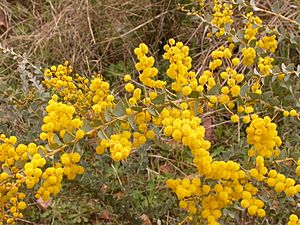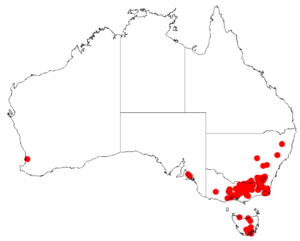Ovens wattle facts for kids
Quick facts for kids Ovens wattle |
|
|---|---|
 |
|
| Scientific classification | |
| Genus: |
Acacia
|
| Species: |
pravissima
|
 |
|
| Occurrence data from AVH | |
The Ovens Wattle (scientific name: Acacia pravissima) is a beautiful flowering plant. It's also known by names like Oven Wattle or Wedge-leaved Wattle. This plant belongs to the pea family, called Fabaceae. It is an evergreen shrub, which means it keeps its leaves all year round. You can find it growing naturally in Victoria and parts of New South Wales, Australia.
Contents
What the Ovens Wattle Looks Like
This plant can grow as a small shrub or a taller tree. It usually reaches about 0.5 to 3 meters (about 1.5 to 10 feet) tall. But sometimes, it can grow much taller, up to 8 meters (about 26 feet)! Its branches are thin and can spread out.
Instead of regular leaves, the Ovens Wattle has special flattened stems called phyllodes. These phyllodes are grey-green and grow close together. They are shaped a bit like a triangle or a wedge. Each one is about 7 to 16 millimeters long and 5 to 14 millimeters wide.
In winter and spring, this wattle produces many bright yellow flowers. These flowers grow in round clusters, like little balls. Each flower cluster is about 5 to 6 millimeters across and has 8 to 12 golden flowers. After the flowers bloom, flat, thin seed pods appear. These pods can be up to 8 centimeters (about 3 inches) long and 6 to 9 millimeters wide. Inside, you'll find dull black seeds, each about 3 to 5 millimeters long.
How the Ovens Wattle Got Its Name
The Ovens Wattle was first officially described in 1853. A botanist named Ferdinand von Mueller gave it its scientific name, Acacia pravissima. Later, another botanist tried to change its name, but it was changed back to Acacia in 2006.
The second part of its scientific name, pravissima, is a Latin word. It means "very crooked." This might refer to the plant's unique, somewhat bent or angled phyllodes.
Where the Ovens Wattle Grows
This plant is endemic to south-eastern Australia. This means it only grows naturally in this specific area. You can find it in the higher parts of the Great Dividing Range. It grows from around Tumut in New South Wales, through the Australian Capital Territory, and down to areas in Victoria.
The Ovens Wattle often grows in places that are damp and sheltered. You might see it along creeks and streams. It usually grows as part of Eucalyptus forests and woodlands.
Growing Ovens Wattle in Gardens
If you live in a place with a mild or warm climate, you can grow the Ovens Wattle outdoors. It needs a sunny spot that is protected from strong winds. It also prefers soil that is not too acidic or alkaline.
In colder areas, it's best to grow this plant in a greenhouse or indoors. It's a popular plant for gardens because it's quite beautiful. It has even won an important award called the Royal Horticultural Society's Award of Garden Merit!
Images for kids



